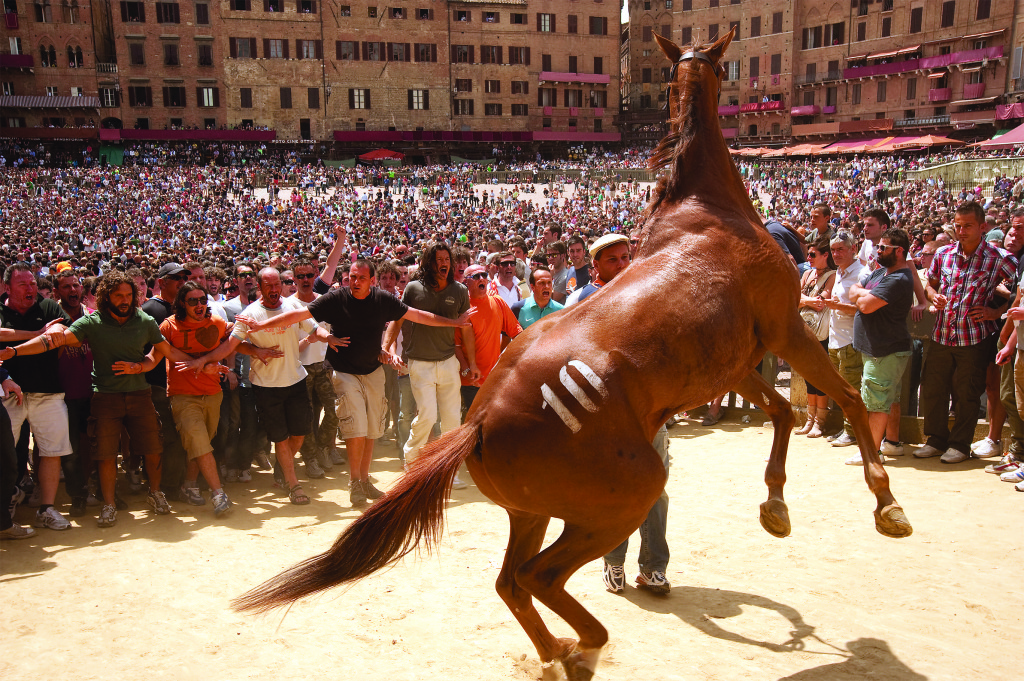Palio
Director: Cosima Spender
Cast: Various
Running Time: 91 minutes
Country: Italy
In the first ten minutes of Palio, directed by Cosima Spender, we are made aware of all the curiosities that make Siena one of the most unique cities in Italy, and the titular horse race that dominates life in the seventeen contrade (districts) for the entire year. But this isn’t a dry tour hrough history, and Spender infuses the entire runtime with the passion, anger and thrill that have turned the Palio into the legendary institution it is today.
Before watching this, it’s best you understand that Italians are a little bit insane. The sheer intensity and diversity within the culture of the country has created a world in which each city is a microcosm of a country, fiercely resisting any attempt and regulation. Therefore, to watch the Palio is to watch Siena, and this is something that Spender focuses on throughout the film, choosing to interview people speaking the inimitable Tuscan dialect (all helpfully subtitled), rather than those who prefer standardised Italian.
Spender’s masterstroke is to focus in on the rivalries between two pairs of jockeys – one nascent, and one defunct. By comparing and contrasting them, she manages to build a picture of the corruption that has come to infect the most dangerous horse race in Europe while drawing us into the stories of these men. In fact, it’s easy to forget that this is primarily a documentary, as Spender draws us into the typically Italian drama that is being wrought between the “King of the Square” and his challenger and heir.
…it’s easy to forget that this is primarily a documentary, as Spender draws us into the typically Italian drama that is being wrought
The music and camerawork only serve to further suffuse the film with a sense of spectacle. With a heady blend of POV, slow-motion and sweeping shots, you can see why the race evokes the intense reactions from the spectators afterwards. The music only adds to this, evoking the feel of Ennio Morricone’s famous score for The Good, The Bad and The Ugly. By the end of the film, it’s hard not to be swept up in the inevitable victory that brings about a happy conclusion, and the stunning combination of the score and camerawork has you on the edge of your seat for the mere ninety seconds that the race actually lasts for.
A word of warning – this film is not for the faint-hearted. For all the pageantry and pomp that surrounds the 800-year old race, the enmity between the various contrade is all too current. After the race, the horses are shown with bloodied hindquarters and vicious cuts all over their bodies, as a result of the nerbo, a sienese whip used to beat both rival horses and jockeys with in the hopes of winning. In addition, while the winning jockey is akin to a god, the losing jockey is considered traitorous and often subjected to verbal and physical abuse.
Ultimately, this is a very Italian exercise in film-making. Everyone in the film admits that the race is more about the money than the horses, and yet no one will admit to culpability. While a protagonist emerges in the second half of the film, no antagonist exists. By allowing us to glimpse the brutal and frenetic underworld that exists alongside the processions and celebration, Palio has fashioned a movie full of the imagination, ecstasy and fury that has always seemed an essential part of the Italian world.
Palio is available to stream now on Curzon Home Cinema.


Comments